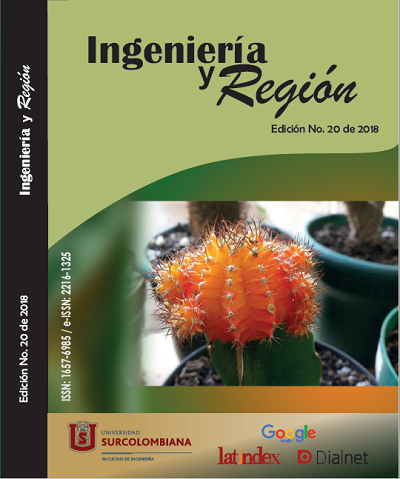Evaluation of the alcoholic fermentation of the grape must Isabella (Vitis labrusca)
##plugins.themes.bootstrap3.article.main##
The Isabella grape (Vitis labrusca) is an ink variety that is grown in “corregimiento la Ulloa” belonging to the municipality of Rivera (Huila), having a demand in local markets for fresh consumption. The main objective of this research was to know if the production of a competent wine was possible compared to commercial wines, for which the process of alcoholic fermentation with yeasts Saccharomyces cerevisiae var Bayanus was evaluated for the grape must, making the chaptalization with honey from bees. For this, physicochemical parameters such as pH, soluble solids, acidity, viscosity and color were analyzed during fermentation; these parameters were measured in the final product to be evaluated against a commercial wine. The results show that the grape variety and the type of maturation influence the final product, so when evaluating both wines significant differences were found (p <0.05) in the parameters measured. Once the ripening process was finished, a comparative sensory analysis was carried out with a Cabernet Sauvignon red wine, where a high level of acceptance was obtained for the Isabella-Huila grape wine with significant differences (p <0.05) between wines. Later, a marriage was made in which the possible foods that better complement the palate of the people were known when consuming the Isabella-Huila grape wine, being the mature cheese the most accepted, followed by ham, cherries and finally the fresh cheese.
Downloads
##plugins.themes.bootstrap3.article.details##
Aleixandre Benavent, J., & Aleixandre Tudó, J. (2010). Manual de vinos y bebidas. Valencia: Universidad politécnica de Valencia.
Almanza Merchán, P. J., Reyes M, A. J., Ayala, M. L., Balaguera L, W., & Serrano Cely, P. A. (2015). Evaluación sensorial del vino artesanal de uva Isabella (Vitis labrusca L.). Ciencia y Agricultura (Rev Cien Agri) Vol. 12 ( 2). ISSN 0122-8420, 71-81. DOI: 10.19053/01228420.4393
https://doi.org/10.19053/01228420.4393
Almanza, P.J.; Serrano P. y Fisher, G. Manual de viticultura tropical. Tunja: UPTC, 2012.
Apella, C. M., & Araujo, Z. P. (2005). Conceptos Básicos. Tecnologías Solares para la Desinfección y Descontaminación del Agua. Microbiología del agua, 33-50.
Ármas Benitez, R., Ayerra Balduz, P., & Lopez Arias, M. (s.f.). Normas prácticas para la elaboración de vinos en canarias.
Benucci, I., Fiorelli, V., Lombardelli, C., Liburdi, K., Esti, M., Kinectic characterization of arginase from Saccharomyces cerevisae during alcoholic fermentation at different temperatures, LWT- Food Science and Technology(2017), DOI: 10.1016/j.lwt.2017.04.044.
https://doi.org/10.1016/j.lwt.2017.04.044
D'Amato, D., Corbo, M.R, Del Nobile, M.A, & Sinigaglia, M. (2006). Effects of temperature, ammonium and glucose concentrations on yeast growth in a model wine system. International Journal of Food Science and Technology, 41, 1152-1157, DOI: HYPERLINK "https://doi.org/10.1111/j.1365-2621.2005.01128.x" 10.1111/j.1365-2621.2005.01128.x.
https://doi.org/10.1111/j.1365-2621.2005.01128.x
Etaio Alonso, I., Pérez Elortondo, F. J., Albisu Aguado, M., Salmerón Egea, J., Ojeda Atxiaga, M., & Gastón Estanga, E. (2007). "Guía para la evaluación sensorial de la calidad de los vinos tintos de Rioja Alavesa" Vinos jóvenes y vinos con crianza. Vitoria-Gasteiz: Servicio central de Publicaciones del Gobierno de Vasco.
https://doi.org/10.35376/10324/1900
Madigan, M. T., Martinko, J. M., Dunlap, P. V., & Clarck, D. P. (2009). Brock Biología de los microorganismos. Pearson Prentice Hall. 144-147p.
Méndez, P. D. (Noviembre de 2015). Efecto del uso de levaduras y concentración de °Brix en las características fisicoquímicas y sensoriales de vino de fresa con miel. Zamorano, Honduras.
https://doi.org/10.17533/udea.vitae.v24n2(2)a06
Napoli, A. D. (2013). In vino veritas. Colombia: Panamericana.
OIV, O. i. (10 de Mayo de 2017). Uvas de mesa y pasas: los datos mundiales estan disponibles. Obtenido de http://www.oiv.int/es/actualidad-de-la-oiv/uvas-de-mesa-y-pasas-los-datos-mundiales-estan-disponibles
https://doi.org/10.4000/books.uec.1002
Robles, R. C., Muñoz, F. O., & Chirre, F. J. (2016). Estudio del consumo de azucares reductores durante la fermentación alcohólica del mosto de uva Italia para la obtención de vino blanco. Revista Industrial Data N° 19, p 104-110. DOI: 10.15381/idata.v19i2.12842.





 Perfil Google Scholar
Perfil Google Scholar













